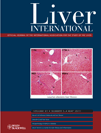Stage progression of small hepatocellular carcinoma after radical therapy: comparisons of radiofrequency ablation and surgery using the Markov model
Abstract
Background: Stage progression of 374 small hepatocellular carcinomas (HCC) was retrospectively analysed.
Patients and methods: During 8 years, 236 patients with the early stage of HCC received radiofrequency ablation (RFA), and 138 underwent surgery as an initial therapy. More patients of young age and with better liver function tended to undergo surgical treatment. Based on 1892 patient-year data, the Markov model analysed the stepwise progression of early stage (multiple up to three nodules, 3 cm or less each) to intermediate stage (four nodules or more, or larger than 3 cm), to advanced stage (portal invasion, extrahepatic metastasis or Child–Pugh C) and to death.
Results: The recurrence rates after RFA and surgery were 53.3 and 40.6% in the third year. The annual progression rates from the early stage to the intermediate stage, advanced stage and death were 5.40, 1.63 and 1.73% in the RFA group and 3.90, 1.87 and 0.62% in the surgery group respectively. The progression rate from the early to the intermediate stage was significantly lower (2.34% annually) in the younger patient group (<60 years) than that in the older group (≥60 years, 5.70%, P=0.0053). In contrast, the progression rate from the intermediate to the advanced stage was significantly higher in the younger patient group (<60 years, 37.50% annually) than that in the older groups (60–69 years, 30.30%, 70 years or older 22.09%, P=0.0011). Multivariate hazard analysis showed that initial treatment did not significantly affect the stage progression rate (hazard ratio of RFA 1.09, P=0.70) and the survival rate (hazard ratio of RFA 1.09, P=0.73).
Conclusion: Although the recurrence rate was slightly higher in the RFA group, additional ablation procedures could control the progression of HCC, with a rate comparable to the surgical group.




